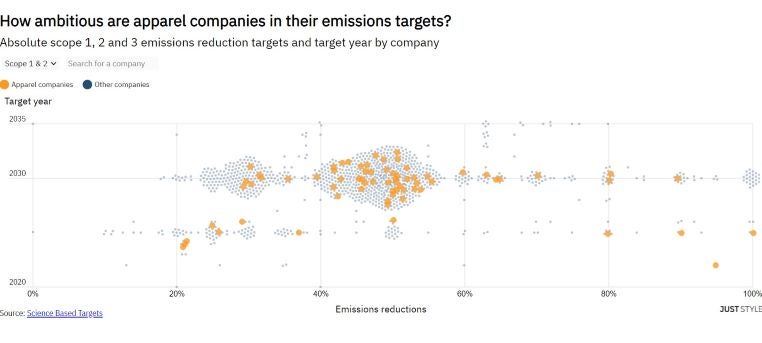
Just 100 companies have been the source of over 70% of emissions since 1988, according to a study by the international non-profit organisation CDP in 2017. Pushing the private sector and in particular the apparel industry to contribute to reducing emissions seems like a necessary step for reducing global emissions.
“Unless businesses act now, climate change will ever more deeply damage economies, increase scarcity, drain profits and job prospects, and impact us all,” explains Earth Day Network on its website.
Most companies have some form of climate strategy in place. However, without clear guidelines and accountability, there is a risk of unclear targets, empty promises, and greenwashing.
When investigating the climate strategies of 25 major global companies, the non-profit NewClimate Institute found that pledges made in these public strategies are often ambiguous and emission reduction commitments are limited.
“All of the 25 companies assessed in this report pledge some form of zero-emission, net-zero or carbon-neutral target,” the researcher wrote. “But just three of the 25 companies (…) clearly commit to deep decarbonisation of over 90% of their full value chain emissions by their respective net-zero and zero-emission target years.”
With the lack of regulation, there is a growing need for companies to set clear and credible targets. This is where independent certification schemes such as the Science Based Targets initiative (SBTi) come in.

US Tariffs are shifting - will you react or anticipate?
Don’t let policy changes catch you off guard. Stay proactive with real-time data and expert analysis.
By GlobalDataThe SBTi is a collaboration between CDP, the United Nations Global Compact, World Resources Institute and the World Wide Fund for Nature. Over 1,300 companies have joined with science-based targets that are in line with the Paris Agreement goals and approved by the SBTi.
The big picture: Apparel companies’ emissions targets
Just Style analysed the emissions reduction targets of the companies in the database of the SBTi. Because it can be difficult to compare targets between different companies and sectors, the analysis only includes the companies with absolute targets. Absolute targets are only relative to a baseline, while intensity targets – the ones that were excluded – are relative to a unit or economic output, for example, a reduction of emissions per million dollars of profit.
The data shows that fewer companies are committed to Scope 3 than to Scope 1 & 2, and the targets set for Scope 3 are less ambitious.
Scopes are categories of emissions set by the Greenhouse Gas (GHG) Protocol, a framework for reporting greenhouse gas emissions from the private and public sectors. Scope 1 covers direct emissions from owned or controlled sources, scope 2 covers indirect emissions – for instance from the generation of electricity – and scope 3 covers all other direct emissions from the value chain.
Setting scope 3 targets as a company is just as important, if not even more, as setting targets for scope 1 and 2, explains SBTi: “For the majority of sectors, the largest sources of a company’s emissions lie upstream and/or downstream of their core operation”.
Taking the average of reported targets of the companies in each sector indicates how ambitious each sector is compared to others. Calculating the average target by sector was done by averaging the percentage of the reduction target and averaging the timeframe between the base year and the target year.
Based on an average of 71 companies, the textiles sector has committed to reducing 49.3% of its emissions in 10.9 years. That is more ambitious than the average of all companies. Across all companies in the database the average target is for a reduction of 44.6% in a timeframe of 12 years.
Among companies in the apparel and textiles industry, fashion brand Eileen Fisher has the highest commitment, with a reduction of emissions of 100% by 2025. The runner-up was luxury fashion brand Burberry Limited with a pledge to reduce 95% of its emissions by 2022.
At the opposite end of the scale, two apparel and textile manufacturers were found to lag compared to other apparel and textile companies. The apparel manufacturer Olive Apparel (Cambodia) Co., Ltd. which is based in Cambodia and the manufacturer Pine Tree Company For Textile Manufacturing PSC, which is based in Jordan have reductions targets of 21% by 2024.
The SBTi categorised each target set by companies based on future pathways. The trajectory can either be towards a 1.5°C, well below 2°C, or 2°C above pre-industrial levels by 2050.
To avoid the most significant consequences of climate change, the rise in global temperature needs to stay below 1.5°C above pre-industrial levels by 2050. However, the latest report from the Intergovernmental Panel on Climate Change (IPCC) shows the current trajectory will result in global warming of between 2.2 and 3.5°C. In response to the urgent need to reduce emissions further, the SBTi will “only accept target submissions of scope 1 and 2 targets that are in line with a 1.5°C trajectory” as of 15 July 2022.
With a total of 67 companies, most companies with absolute and intensity targets in the apparel and textiles sector are in line with a trajectory towards 1.5°C above pre-industrial levels by 2050, while four companies wouldn’t be able to submit their targets under future SBTi norms.



